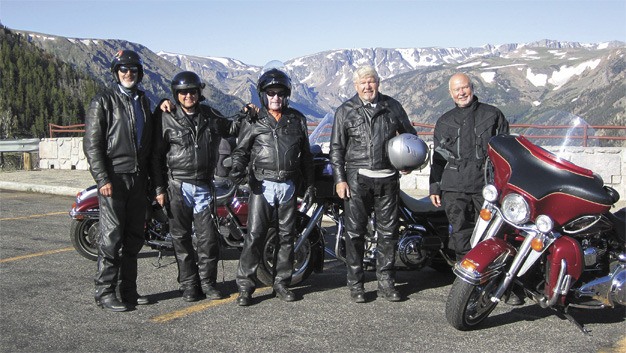Spectacular scenery, the wind in their faces and time to get lost in their own thoughts, were just a few of the benefits three members of the “Mercer Island Retired Ones” (MIRO) motorcycle group gained on a seven-day ride earlier this month.
All longtime Island residents, retired State senator Jim Horn, retired Harley-Davidson executive Martin Snoey and retired orthopedic surgeon, Marr Mullen, took off with six other men on what they called the “Four of 15 in Seven” ride.
The name of the ride refers to four of the 15 best motorcycle rides in the United States as compiled by the American Motorcycle Association, accomplished in seven days.
Of the nine, the three from Mercer Island and Hans Koning-Bastiaan of California were the only four who finished. Not that the others had problems; rather, obligations to go home to.
Snoey started MIRO in 2000 along with Mullen and David Jack, formerly of Mercer Island.
“Others have joined over the years, and Jim has been riding with us about a year,” Snoey said. “This organization has spawned rides all over North America.”
He said they’ve ridden the Alaska Highway and also in New Zealand where they rented their bikes. Snoey plans all the trips.
“My warped and twisted mind took a look at this list and said, hey, look at these four, why don’t we do all four of those in one ride?” he said.
The ride was set. The four best rides in their own backyard.
They set out east to Spokane, cut north to Canada traveling through North Idaho, then dropping back into the United States, riding the “going to the sun road” in Glacier National Park, Montana, number six on AMA’s list, which hits an elevation of 6,653 feet.
Snoey said when they entered Canada, the customs agent wanted to know the name of their “gang.”
Not the camping type, the riders stayed in hotels each night, where they where eager to hit the shower, perhaps a swimming pool, have their social hour, which they called “board meetings,” and have a good dinner before hitting it all again the next day.
With a total of 2,400 miles to cover, the men averaged 343 miles each day, which was do-able with stops for breaks. While on the road, the riders used hand signals to communicate rather than headsets. Horn said they rode staggered, one second behind the bike in the adjacent lane, and two seconds behind the bike in front of them so they had time to react in case of an emergency.
From Glacier, they dropped south through Montana headed for number one on AMA’s list, the Beartooth Highway, which is in both Montana and Wyoming.
“The Beartooth Highway goes over a pass that’s 10,947 feet high, the highest pass that’s not in the Continental Divide, and the ride lasts 64 miles,” Snoey said.
All three men said it was so clear on the Beartooth Highway, they could see for 75 miles. Horn said the top is fairly level, and you can even hit ice in the summer, but they got lucky.
Heading west and north, next on the list was U.S. route 12, or the Lolo Pass, elevation 5,235 feet, which starts near Missoula, Mont., ends in Idaho and is number nine on AMA’s list. The Lolo pass is also part of the Lewis-Clark trail.
Crossing through Idaho, their final goal was AMA’s ride number 15: Washington Route 129 and Oregon Route 3, from Clarkston, Wash., to Enterprise, Ore., a twisty but beautiful route, one of the highlights of the ride along with the scenery in Glacier and Yellowstone.
All told, the group went through British Columbia and Alberta in Canada, Washington, Idaho, Montana and Oregon. Just for kicks, they rode through Mt. Rainier National Park before returning home. Along the way, they saw deer, elk, grizzly bear in Yellowstone, bison and mountain goats.
They had no rain, but did have to deal with road construction, a few minor mechanical problems, high heat, thunderstorms and 10 to 11 hours a day “in the saddle.” But these bikes are touring bikes, weighing approximately 900 pounds, so they are comfortable, with plenty of room for their gear, first aid and tools for the bikes.
Snoey has ridden in all 50 states, but this was Horn’s first long ride.
“It’s such a diverse group, from different backgrounds,” Horn said.
Mullen has been on all of MIRO’s rides except the trans-Canada ride, and knows all the local roads in Western Washington. His T-shirt said it all: “You never see a motorcycle parked outside a psychiatrist’s office.”
And what do their wives think of all of this?
Horn said he had a Harley back in college, when his then-girlfriend, Joyce, would ride on the back with him. Now his wife, she’s content to let him go. However, he said the largest group of new riders are women.
With four of the 15 best rides under their belts, who knows where MIRO riders will go next.
Snoey summed it up.
“Every day on a Harley is a day that’s not subtracted from your life,” he said.



